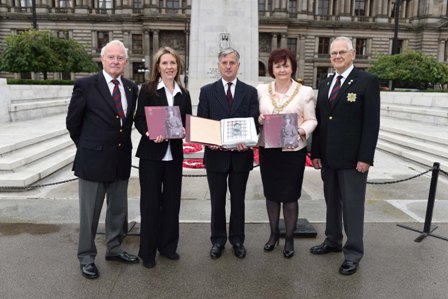VC hero remembered
Glasgow's Lord Provost and a descendant of one of the city's earliest First World War heroes was today (Monday 15 September) presented with a unique book outlining his heroism at the City Chambers.

Private Henry May, a reservist with the Cameronians (Scottish Rifles), braved a "hail of lead" to rescue soldiers, including his platoon commander, at La Boutillerie, France on 22 October 1914. Modest about his actions, Private May from Bridgeton later said: "I just did what any man in the regiment would have done to bring in a wounded man." Jennifer McInnes, the great-granddaughter of Private May VC, joined the Lord Provost to honour her ancestor. |
Jennifer said: "I was a child when I found out that my great-grandfather had won a Victoria Cross and I have always felt very proud and compelled to find out more about him.
"I feel grateful and very touched that Mr Murray chose my ancestor as one of the VC recipients he researched.
"Through this book I have discovered information that had previously been unknown to my family, including Henry's attendance at the burial of the Unknown Warrior and the unveiling of the Cenotaphs at both Westminster and George Square.
"I am delighted Mr Murray's book has been recognised and that it will be preserved in the Lord Provost's archives."
King George presented Private May with his VC on 12 August, 1915. May was discharged from the Army on 28 August 1915, when his regular engagement of 13 years had expired. He rejoined in 1918 and attained the rank of Lieutenant.
The Victoria Cross is the highest honour to be awarded for gallantry.
May's battalion had been building trenches at La Boutillerie. A platoon had been sent out to form a screen to protect those behind. May recalled advancing 800 yards to a ditch, while the platoon held back the enemy until the trenches were dug.
However, when they tried to return, the Germans opened fire. Lance Corporal Lawton was shot, and May went to his aid. He later recalled: "I ran across the firing line, through a hail of lead, followed by two of my chums, Lance Corporal James McCall and Private James Bell."
May and McCall pulled Lawton to his feet. The platoon commander, fellow Glaswegian Lieutenant Graham, had followed them and fired back at the Germans, but Lawton was shot and died in May's arms. McCall had been shot too and was unconscious.
May threw himself to the ground. Then Graham was shot. "He was behind me, I had to go back," recalled May. "It was great devotion that impelled me to rescue him. He had been so good to us." May and Bell retrieved Graham and zig-zagged a quarter of a mile when Bell was wounded. They were still 300 yards from the trenches.
Another soldier, Corporal Taylor, came running from cover and shouted to May to lift Graham on to his shoulders - a moment later, Taylor was shot dead while holding Graham, who was hit by the same bullet. Graham told May to leave him, but May reached the trenches and sent out stretcher bearers.
On his return to the city, May received a rapturous welcome and was carried aloft through Central station.
Lieutenant Graham survived and, years later, was promoted to Major General and Regiment Colonel of the Cameronians.
Following the war May resumed his work in textiles in Bridgeton, where he lived with his wife and children.
His bravery is currently enshrined in a series of granite paving slabs, inset with local VC holders' names, at Bridgeton Cross.
May, alongside ten other Glasgow born VC recipients, are being honoured with a personal memorial paving stone as part of the UK's First World War commemorations.
The heroism of Private May has been researched by Mr Jack Murray, a Scots Guard veteran and former police officer.
The amateur historian, who has been researching VC recipients, presented Jennifer McInnes and the Lord Provost with a copy of the book he compiled on behalf of the Scots Guards Association.
Mr Murray was joined at the special ceremony by members of the Glasgow branch of the Scots Guards Association.
Ten prints of the book have been produced, with copies also going to the Cameronian museum in Hamilton and the National War Museum in Edinburgh.
The book details Henry May's service, award and homecoming with photographs and newspaper cuttings from the time. It will be placed in the Lord Provost's archives within the City Chambers as a tribute to one of Glasgow's wartime heroes.
The Lord Provost said: "Honouring our VC recipients is one of the central themes of Glasgow's First World War commemoration.
"This book gives a fascinating insight into the remarkable achievements of Henry May. That it was researched by a veteran makes it a truly fitting tribute.
"By placing this book in the City Chambers archives we will preserve the story of Henry May for future generations.
"The First World War had a profound impact on Glasgow, from the front line to the home front.
"We want to encourage people to delve in to their own family stories and add them to our website, so those important accounts can be collected and shared."
Mr Murray, 79, has been researching Henry May for a number of years. He said: "I feel it is important that the sacrifice made by Henry May and others who fought in the Great War are remembered, before these stories die out forever.
"Having spent the past four years researching and working on this book I will be sad to part with it but also very pleased to know it will be kept safely in the Lord Provost's archives. The Scots Guards Association has been tremendously supportive of my work and I am proud to present this book on their behalf.
"I am also working on a number of other books, including one to commemorate Glaswegian VC winner Robert Downie. I also hope this can be kept in the City Chambers."
Mr Murray's book is now available to view and download. ![]() Henry May VC by Jack Murray [5Mb]
Henry May VC by Jack Murray [5Mb]












